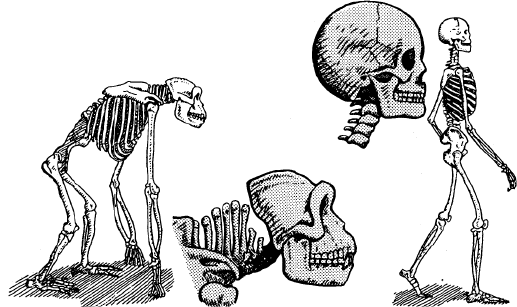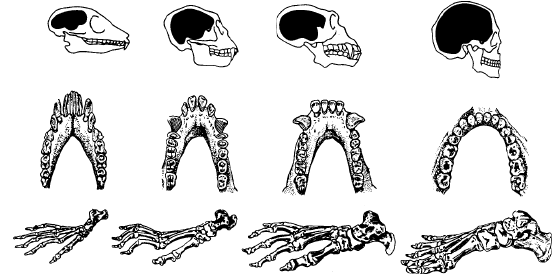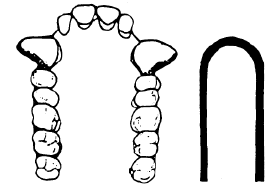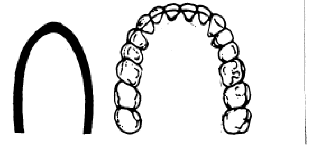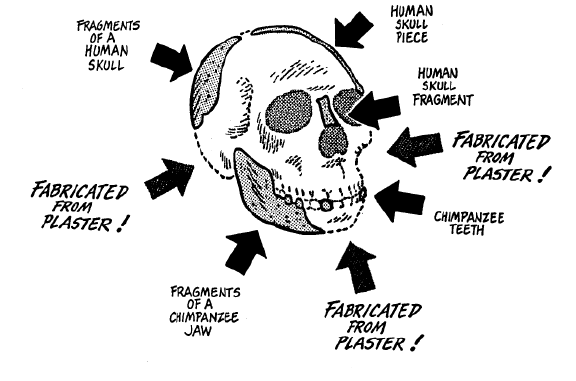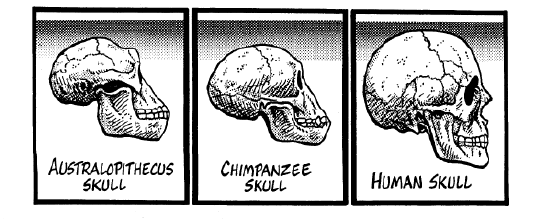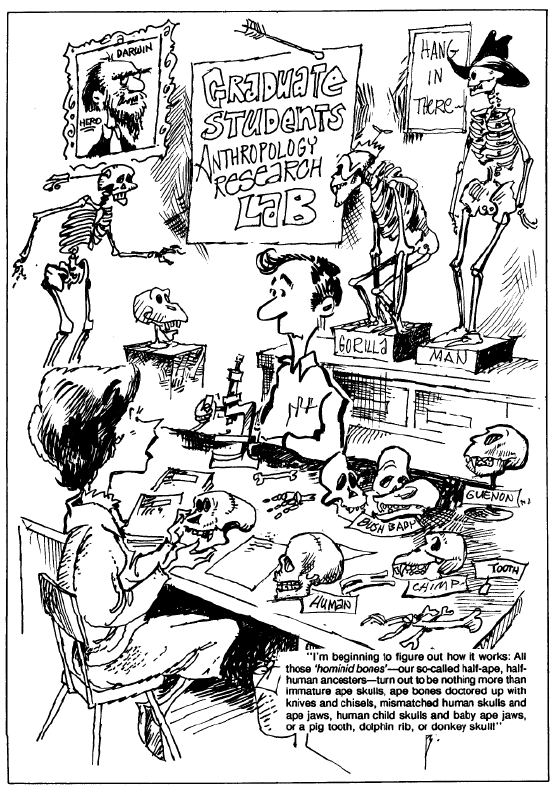|
| |
Evolution Encyclopedia Vol. 2 Chapter 18 ANCIENT MAN
CHAPTER 18 - ANCIENT MAN BASIC ARRANGEMENT OF THIS CHAPTER
Appendices
Related studies:
In the previous chapter (on fossils) we examined the supposed evidences for the past evolution of plants and animals. In this chapter we will view the imagined ancestry of human beings. Following an introduction, this chapter is divided into two main sections: Hominids and Early Man. The section on Hominids will deal with what is called prehistoric man, or what we might call "the man of evolution. " In some respects it is an addition to the chapter on fossils, although it reads more like a sideshow as it tells about fakeries such as Piltdown Man, Java Man, Tuang Man, etc. The next section, Early Man, will be about actual geologic or historical evidences of ancient peoples, and is about the "man of history. " It is somewhat paralleled by information near the end of chapter 7 (Age of the Earth), in the section entitled Evidence from Civilization. 1 - INTRODUCTION From grade school on up, children are taught about "cavemen," and are gradually conditioned to the idea that we evolved from lower forms of life. They are also taught about the bones and skulls of our "ancestors." As adults, we frequently hear reports of fossil remains of ape-like humans that have been found. Each discovery has been hailed as a landmark proof of the theory of evolution. Scientists have named these supposed half-man/half-ape remains; they call them hominids. Is it really true that such skeletal remains have been found? Are we really related to apes? In this a chapter you will examine the evidence and thus find solid answers. For additional information see quotation supplement, "1- Man's Ancestry Unknown to Scientists," in the appendix. APES—Evolutionists teach two variant theories regarding man's direct ancestor: (1) man and ape came from a common ancestor about 5-20 million years ago; (2) man descended from an ape For additional information see quotation supplement "13 - The Evolutionary Ancestor of Man," in the appendix. Modern man is said to have evolved until about x 100,000 years ago—and then stopped evolving. It is claimed that, since that time, man has a switched over from "physical evolution" to "cultural and social evolution." This is an attempt to explain the fact that, in historical records, evolution has never been known among people. There is no evidence that evolution is now—or has ever—occurred among animals or plants either. Are they culturally evolving now also? In addition, it is strange that if man is essentially the same as he was a million years ago, then why did he only begin leaving writings, buildings, and artifacts during only the last few thousand years? Why does human history only go back less than 5,000 years ago? "The search for the proverbial 'missing link' in man's evolution, that holy grail of a never-dying sect of anatomists and biologists, allows speculation and myth to flourish as happily today as they did fifty years ago and more." —*Sir Solly Zuckerman, "Myth and Method in Anatomy," in Journal of the Royal College of Surgeons of Edinburgh (1966), Vol. 11 (2), pp. 87-114. Did man descend from the apes? Our DNA is totally different from that of each of the apes, monkeys, and all the rest. The number of vertebrae Ian our backbone is different from that in the apes. Our cranial (brain) capacity is totally different from the great apes. Orangutans-275-500 cc. Chimpanzees-275-500 cc. Gorillas-340-752 cc. Man-1100-1700 cc. Cranial capacity is, by itself, an important test of whether a skull is from a man or an ape.
Evolution teaches that we descended from the great apes, and they from the gibbons and other smaller apes. But here are some interesting oddities: (1) Birth weight as a percent of maternal weight is, in man, almost twice that of the great apes (5.5 vs 2.4-4.1), but about the same or less than that found in monkeys (5-10) and in gibbons (7.5). (2) Order of eruption of teeth is the same in man and in the Old World monkeys, but it is different than that of the great apes. (3) Walking upright is quite different. Man and the gibbon GORILLA AND MAN *Charles Darwin said that man descended from an ape: On the left is a representative ape, the gorilla. Carefully notice its bony structure, and compare it with the skeleton of a human, on the right. Two facts are obvious: (1) Both were designed by the same highly-intelligent Creator; (2) the two structures are otherwise very, very different. The skulls are totally different, and so are the neck bones,
remainder of the spines, and the ribs. The upright stance of the human
requires a doubly curved spinal column and a large gluteus maximus
muscle. The junction of the spinal cord and the skull is farther forward
on the human, so the head can balance in an upright position. Note the
massive gorilla jaw and heavy bony crest at the top of the skull, needed
for anchoring the jaw muscles.
As with the other teachings of evolution, scientific facts are on the side of the creationists, and the evolutionists and their incredulous theories are outside the domain of scientific fact, discovery, and law. The shape and arrangement of the teeth, for example, is quite different for apes and man:
For additional information see quotation supplement, "2 - From Ape to Man, " in the appendix. PRIMITIVE PEOPLES—Early civilizations were advanced, but from time to time, groups would migrate to new areas and for a time live in "stone age cultures," until they had opportunity to build cities, plant, and engage in animal husbandry ("Science Year: 1966, p. 256). In some localities, the climate and environment have been difficult enough that groups have continued down to the present time in stone-age conditions. Such racial groups can be found in New Guinea, and certain other areas. Some of these peoples have lost a knowledge of agriculture and the making of weapons, tools, or houses. They only have a few crude stone and bamboo tools, and no weapons. They live under the trees in the open, and the men spend each day gathering worms, leaves, and fruit for the family to eat.
CAVE MEN—The first introduction many children have to evolution are pictures of dinosaurs and cave men. It is true that there have been groups that have lived in caves. They wandered from warm climates to colder ones and chose to live in caves for a time before building themselves homes in a new land. But the fact that some people lived in caves for awhile does not prove evolution from one species to another. *Diodorus Siculus, writing about 60 B.C., told of people living along the shores of the Red Sea in caves. He describes many other barbarian tribes, some of them quite primitive. Thus we see that both advanced civilizations and more backward cave cultures lived at the same time. We have no reason to conclude that the less advanced peoples were ancestors of the more advanced ones. Archeologists tell us that in some places in Palestine, people resembling the Neanderthal race lived in caves, while not far away in Jericho people dwelt in well-built, beautifully-decorated houses. NEANDERTHALS —Evolutionists call the cavemen, "Neanderthals." Scientists recognize that they had bowed legs due to rickets, caused by a lack of sunlight. In 1856 workers blasted a cave in the Neander Valley near Dusseldorf, Germany. Inside they found limb bones, pelvis, ribs, and a skull cap. The bones were examined by both scientists and evolutionists. Even that ardent evolutionist and defender of *Darwin, *Thomas H. Huxley, said they belonged to people and did not prove evolution. *Rudolph Virchow, a German anatomist, said the bones were those of modern men afflicted with rickets and arthritis. In 1886, two similar skulls were found at Spy, Belgium. In the early 1900s, a number of similar specimens were found in southern France. Over a hundred specimens are now in collections. A French paleontologist named *Maroellin Boute said they belonged to ape-like creatures, but he was severely criticized for this even by other evolutionists, who said this fossil was just modern man (Homo Sapiens), deformed by arthritis. A most excellent, detailed analysis of how rickets and arthritis caused the features peculiar to Neanderthals, was written by * Ivanhoe in a 1970 issue of the scientific journal, Nature. The article is entitled, "Was Vlrchow Right About Neanderthal?"
Neanderthal features include a somewhat larger brow ridge (the supra orbital torus), but it is known that arthritis can make this more prominent. Virchow noted that the thighbone (femur) was curved, a condition common to rickets. Lack of Vitamin D causes osteomalacia and rickets, producing a subtle facial change by increasing the size of the eye cavity (orbit) especially vertically. *D.J.M. Wright in 1973 showed that congenital syphilis could also have caused the kind of bone deformities found in Neanderthal specimens. The same year, *H. Israel explained that certain living individuals today begin to develop Neanderthaloid features—the heavy eyebrow ridges, elongated cranial vault, and so on—with extreme age. The Neanderthals apparently lived at a time when there was not as much sunlight. We know that the ice age came as a result of worldwide volcanic dust pollution. The weather in Europe at that time was cold enough that they may have stayed so much in their caves that they did not obtain enough sunlight, especially due to the overcast sky conditions. They may also have lived longer than men do today. Biblical records indicate that those living just after the Flood (on down to Abraham and even Moses) had somewhat longer life spans than we do today. Here are two facts you will not find in the textbooks: (1) In 1908 a typical Neanderthal skeleton was found in Poland. It had been buried in a suit of chain armor that was not yet fully rusted. ("Neanderthal in Armour," in *Nature, April 23, 1908, p. 587.) (2) A Neanderthal skeleton was found in the Philippine Islands in 1910. Due to the extreme moisture of that land, it would be impossible for the skeleton to be as much as a century old ("Living Neanderthal Man," in 'Nature, December 8, 1910, p. 176). A third interesting fact is that the Neanderthals had larger craniums than we do! They had larger brains! This indicates digression of our race from a former longer-lived, more intelligent race, rather than evolutionary progression. Brain capacity is an important indicator of whether a cranium (the part of the skull which encloses the brain) belongs to an ape or a person.
They also had well-developed culture, art, and religion. At the present time, most scientists agree that Neanderthals were just plain people that lived in caves for a time. Unfortunately, we are still waiting for this change in thinking to be seen in children's textbooks. Two Neanderthal-like skulls were found in Santa Barbara, California in 1923. Researchers recognized that they were just Indian skulls. Neanderthals were just racial types similar to ourselves. For additional information see quotation supplement," 3 - Neanderthal Man, " in the appendix. THEORETICAL ANCESTRY OF MAN Here is the evolutionists' theoretical ancestry of man: 11) bush baby (Ga/ago) to (2) guenon (Cercopirhecus), to (3) chimpanzee (Pan), to (4) man. But as we compare the skulls with one another, then the teeth, and then the hand and wrist bones, we find that each is a distinct species. One species is supposed to have changed gradually into the other, but there are no transitional species between them either in the fossil record or in our world today. All we have is distinct species, with only gaps between.
The Cro-Magnons were truly human, possibly of a noble bearing. Some were over six feet tall, with a cranial volume somewhat larger than that of men today. This means they had more brains than men have today. Not only did they have some excellent artists among them, but they also kept astronomy records. The Cro-Magnons were normal people, not monkeys, and they provide no evidence of a transition from ape to man. For additional information see the appendix topic, "4 - "Cro-Magnon and Rhodesian Man." 2 - HOMINIDS BASIC QUESTIONS—We will now turn our attention to part of a lengthy line of fakes. As we view them, one by one, there are a few questions we should keep in mind: (1) Why is it that, each time, only one specimen is found? why not hundreds or thousands of them? If these are our ancestors, there should be millions of specimens. There are so many people alive today, there should have been large numbers of half-ape people alive during that "million years" that men are said to have lived on this planet. Indeed, evolution teaches uniformitarianism, the concept that past climates and living conditions were essentially like those we have now in the world. (2) Why are only little pieces of bone found for each specimen—never a complete skeleton? Is this not reading a lot into almost no evidence? Or is it possible that the less found, the easier it is to try to make unfounded claims for it? (3) Although bones decay in a few years in damper regions, and in a few centuries in very dry regions,—why is it that these special bones did not decay even though they are supposed to be "a million years old"? The very possibility that these "million-year bones" are not supposed to have decayed, makes it all the more certain that there ought to be millions of other bones lying around belonging to our ancestors! With millions living today, if people have lived on earth for a million years—the earth should be filled with the bones of our ancestors! (4) How could "million-year bones" possibly be found in damp earth (not encased within solid rock) in Indonesia, China, and England? Yet the evolutionists claim that such bones have been found, as we shall learn below. In an article about the grand opening of the International Louis Leakey Memorial Institute for African Prehistory (TILLMIAP) in Nairobi, Kenya, *Lewin wrote this:
One problem, as indicated above, is all the experts work with is such things as jaw fragments, broken skull pieces, and parts of other bones. No complete or even half-complete skeleton, linking man with the rest of animals has ever been found. But, working with pieces collected here and there, Imagination can produce most wonderful "discoveries." APE AND HUMAN DENTAL STRUCTURE Here is a top view of the teeth of an ape and a man. The "magnets" in the center show the fundamental difference in the shape of the two systems. It is obvious that there is little similarity.
JAVA MAN—In 1891, Java Man was found. This is a classic Instance of a man searching for evidence to support a theory. * Eugene Dubois became a convinced evolutionist while attending a Dutch college. Dropping out of school, he began searching for fossils in Sumatra and other Dutch East Indies islands. He shipped thousands of crates of regular animal bones back to Holland, and then went to Java. In September 1891 near the village of Trinil in a damp place by the Solo River, Dubois found a skull cap. A year later and fifty feet from where he had found the skull cap, he found a femur. Later he found three teeth in another location in that area. Dubois assumed that (1) all these bones were from the same individual, and (2) that they were as much as a million years old. Nearby, in the same condition (indicating the same approximate age) he also found two human skulls (known as the Wadjak skulls), but he did not publicize this find, for they had a cranial capacity somewhat above that of modern man. Thirty-one years later, in 1922, he admitted the Wadjak skull find. Excitedly, Dubois reported the find (the pieces of bone) as "Java Man", and spent the rest of his life promoting this great discovery. The thigh bone was a normal human upper leg bone. As might be expected, many experts questioned whether all the bones came from the same person, and even if they did, they said they were human bones, not ape bones. But Dubois spent most of the remainder of his life lecturing and telling people about the "half-human half-ape" bones that he had found in Java in 1891-1892. He named it Pithecanthropus erectus (erect ape-man). British zoologists thought it was human, German experts decided it was ape, and the French conjectured that it was something between the two. Finally, in 1907 a German expedition was sent from Berlin to Java to settle the matter. But Dubois would not show them his "bone collection" nor help them in any way. Arriving in Java, they went over the Trinil site thoroughly, removed 10,000 cubic meters of material and 43 boxfuls of bones, and then declared it all to be wasted time. Their main discovery was that Dubois' Java Man bones had been taken from a depth that came from a nearby volcano. It had overflowed in the recent past and spewed forth lava which overwhelmed and buried a number of people and animals. About 15 years before his death, and after most evolutionists had become convinced that his find was nothing more than bones from a modern human,—Dubois announced his conviction that the bones belonged to a gibbon! School textbooks and popular books for the public continue to cite 500,000 years as the age of "Java Man," which, admittedly, is quite an imaginary figure. For additional information see quotation supplement,"5 - Java Man," in the appendix. PILTDOWN MAN—In 1912, Piltdown Man was found. This created a great sensation in both the newspapers and halls of science when it was announced by the British Geological Society. They gave it the scientific name, Eoanthropus dawsoni. For nearly 40 years the scientific world bowed before Piltdown Man as the great key to human evolution. Only one specimen existed, when there ought to be thousands if it was really genuine. Paintings were made of the great men who found and worked on it, and three of those men were later knighted by the king of England. Such is the stuff of glory. Ignored was the report of a dentist in 1916 who said that the teeth had been filed down by someone. In 1953, *Joseph Weiner and *Kenneth Oakley applied a recently-developed fluorine test to the bones—and found that Piltdown Man was a grand hoax! Someone had taken an ape jaw and put it with a human skull, filed the teeth somewhat, and then carefully stained it all so that the bones looked both ancient and a matching set. Imported mammalian fossils and handcrafted tools were placed nearby. It took 40 years to figure out that particular hoax.
For additional information see "10 - The Story of Piltdown Man," and the quotation supplement, "6 - Piltdown Man," at the end of this chapter PILTDOWN MAN Piltdown Man was accepted as the great "missing link" for 40 years until finally exposed as a fraud. Parts of a chimpanzee jaw and teeth had been carefully altered, and then combined with doctored parts a human skull. Only a very few bones were used, to enable the fabricators to "reconstruct" the skull in the shape of an "ancestral man."
RHODESIAN MAN—In 1921, Rhodesian Man was discovered in a cave. Anthropologists and artists set to work turning him into a half-ape, half-human sort of creature. But then a competent anatomist had the opportunity to examine it, and found that this was just a normal human being. Further analysis revealed dental caries which modern diets tend to produce, and also a hole through the skull made by a bullet or crossbow. So Rhodesian Man was not so ancient after all. TAUNG AFRICAN MAN—Taung African Man was found in 1924 by * Raymond Dart, when he came across the front face and lower jaw of an immature ape in a cave in the Taung limestone quarry of South Africa. He rushed to report it, accompanied by extravagant claims. A majority of scientists rejected this find, but the press loudly proclaimed it to be the "the missing link." Today most experts dismiss it as the skull of a young ape.
NEBRASKA MAN—Nebraska Man was found in 1922. Well, not exactly. A single molar tooth was found in 1922,—and called "Nebraska Man" Based on that one tooth, an artist was told to make a picture. He did so and it went around the world. Nebraska Man was a key evidence at the Scopes trial in July 1925 in Dayton, Tennessee. In 1928, it was discovered that the tooth belonged to "an extinct pig"! In 1972, living specimens of the same pig were found in Paraguay. *Grafton Smith, one of those involved in publicizing "Nebraska Man" was knighted for his efforts in making known this fabulous find. For additional information see quotation supplement, "7 - Nebraska Man," in the appendix. PEKING MAN—Peking Man emerged on the international scene in the 1920s. The finances of *Davidson Black were just about running out, and he needed help, when in 1927 he found a tooth near Peking, China. The *Rockefeller Foundation stepped forward and gave him $80,000 to continue research on this colossal find. So Black continued looking and came up with a skull, copies of which are displayed today in biology laboratories. Black named it Sinanthropus pekinensis ("China man from Peking"), and received honors from all over the world for his discovery. After his death in 1934, the Jesuit that helped prepare Piltdown Man (Teilhard de Chardin) took over the work at the site. Then Franz Weidenreich led out until all work stopped in 1936, because of the Japanese invasion of China. Oddly enough, although thousands of animal bones were found in this pit near Peking, only a few human skulls were found, and there was no evidence that they had evolved from anything else—even though there was 150 feet of animal bones in the pit. These human bones totaled 14 skulls in varying conditions, 11 jawbones, 147 teeth and a couple small armbones and femur fragments, along with stone tools and carbon ash from fires. These were human bones, but with a somewhat smaller brain capacity (1,000cc), which some people today have), and with the prominent brow ridges which we find in Neanderthals and Australopithecus. There are races today with larger brow ridges, and some Philippine women have brow ridges—which only men generally have. Patterns vary, but the species remains one.
A braincase of 1,OOOcc is not sub-human; people today vary between 1,000 and 2,000cc, with an occasional low of 750cc, and an average of 1, 500-1, 600cc. All the skulls disappeared during World War II, so we cannot now examine them with modern methods to check their genuineness.
The evidence indicates that this may have been a dining area or garbage dump, and that both animals and people had been eaten.
*Twenty years later, in the 1950s, * Ernst Mayr came up with a new name, Homo erectus, and then put a variety of bone finds (Java Man, Peking Man, and several others) into it. It is well to keep in mind that all that remains of Peking Man are plaster casts in the United States. But plaster casts cannot be considered reliable evidence. AUSTRALOPITHECINES—"Australopithecus" ("southern ape") is the name given to a variety of ape bones found in Africa. After examining the bones carefully, anthropologists have gravely announced that they come from an ancient race of pre-people who lived from 4 to 1 million years ago. These bones have been found at various African sites, including Sterkfontein, Swartkrans, Koobi Fora, Olduvai, Hadar, and Omo River. The Australopithecines, like modern apes, had a wide range of varieties. But they were all apes. One of the most famous was named "Lucy," and will be mentioned again later on. Some experts believe that these apes, the Australopithecines, descended from another ape, the "Aamapithecines" ("Aamepithecus" is the singular for this word), which is supposed to have lived 12 million years ago.
Homo habilis is another ape. In the 1960s, * Louis Leakey found some teeth and skull fragments at Olduvai. He dated them at 1.8 million years ago and decided they belonged to the human family, therefore naming them Homo (people are classified as Homo Sapien. But many experts, including Brace and Metress, have clearly shown that habilis was nothing more than a large-brained Australopithecus. Human beings have a brain size of about 1500 cc (cubic centimeters). In contrast, habilis was 660 cc. Other brain sizes would be 800 cc for Hadar, 900 cc for Koobi Fora. Most other brain sizes are about 500 cc. The Taung and Sterkfontein skulls are around 430 cc apiece, so an adult of their species would only be 550-600 cc. Thus on the score of size of brain case, these finds prove nothing. An excellent and detailed article on this, which includes 13 charts and graphs, will be found in "Some Implications of Variant Cranial Capacities for the Best-preserved Australopithecine Skull Specimens," by Gerald Duffert. (Creation Research Society Quarterly, September 1983, pp. 96-104.) In that article you will find evidence of fraudulent measurements of those ancient African skulls. Repeatedly, when initially measured a high cubic centimeter volume was announced for the skull, but later remeasurements by other investigators disclosed much smaller measurements!
Speaking of the Australopithecines, *J.S. Weiner commented:
AUSTRALOPITHECUS A comparative view of an Australopithecus. chimpanzee, and human skull. The Australopithecus is clearly an ape, and in no way a transition between ape and man.
In 1957, *Ashley Montagu, a leading U.S. anthropologist, wrote that these extremely apelike creatures could not possibly have anything to do with man (*A. Montegu, Man's First Million Years). After the most careful research, *Oxnard and *Zuckerman have come to the conclusion that Asutralopithecines is an ape, and not human, and not a transition between the two.
LUCY— Lucy, one of the most recent of the Australopithecus finds, was unearthed by *Donald C. Johanson at Hadar, Ethiopia in 1975. He dated it at 3 million years B.P. [Before Present]. In 1979, *Johanson and *White claimed that Lucy came under an ape/man classification (Australopithecus afarensis). But even before that startling announcement, the situation did not look too good for Lucy. In 1976, Johanson said that "Lucy has massive V-shaped jaws in contrast to man." (*National Geographic Magazine, 150:790-810.) In 1981, he said that she was "embarrassingly un-Homo like." (Science 81, 2(2):53-55.) Time magazine reported in 1977 that Lucy had a tiny skull, a head like an ape, a brain case size the same as that of a chimp—450 cc and "was surprisingly short legged" (*Time, November 7, 1,979, pp. 68-69). * Dr. Yves Coppens, appearing on BBC-TV in 1982, stated that Lucy's skull was like that of an ape. In 1983, *Jeremy Cherfas said that Lucy's ankle bone (talus) tilted backward like a gorilla, instead of forward as in human beings, who need it so to walk upright, and concluded that the differences between her and human beings are "unmistakable." (*J. Cherfas, New Scientist, (97:172 [1982].) *Susman and *Stern of New York University carefully examined Lucy and said her thumb was apelike, her toes long and curved for tree climbing, and "she probably nested in the trees and lived like other monkeys." (Bible Science Newsletter, 1982, p. 4.) Several scientists have decided that the bones of Lucy come from two different sources. Commenting on this, * Peter Andrews, of the British Museum of Natural History, said this:
Regarding those knee joints, *Owen Lovejoy, *Richard Leakey's highly-qualified anatomist associate, declared at a 1979 lecture in the United States that a multivariate analysis of Lucy's knee joints revealed her to be an ape. So whether Lucy be one creature or two, they are both apes. *Johanson's theory about Lucy is based on an assumption linking two fossils 1,000 miles apart.
*Johanson finally himself decided that Lucy was only an ape.
NUTCRACKER MAN—Nutcracker Man was found in 1959 by *Louis Leakey in the Olduvai Gorge in East Africa, and is one of the Australopithecines, discussed above. Since the Leakeys are frequently mentioned in articles about the bones of man's ancestors, we will here mention that *Louis Leakey was born in Africa, the son of a missionary. He and his wife, *Mary, both had doctorates. Attar his death, his son *Richard, who never obtained a doctorate, has continued bone hunting with his mother. Olduvai Gorge is located in East Africa, about 100 miles west of Mount Kilimanjaro. It consists of a 300-foot gorge that has cut through five main horizontal beds. *Louis Leakey called his find Zinjanthropus boisel, but the press called it "Nutcracker Man" because it had a jaw much larger than the skull. It was probably another case of mismatched skull parts. The skull was very ape-like, but some tools were nearby, so Leakey decided that it had to be half-human. Slim evidence, but that is how it goes in the annals of evolutionary science. When he first announced it, Leakey declared that it was the earliest man, and was 600,000 years old! Although the age was a guess, it came just as funds from *Charles Boise ran out. A new sponsor was needed, and the *National Geographic Society stepped in and has funded the Leakeys ever since. In 1961, the skull of Nutcracker Man was dated by the notoriously inaccurate potassium-argon method (see Dating Methods chapter) at 1.75 million years. That story really made the headlines! In 1968, the same materials were dated by Carbon 14, which, although quite inaccurate, is far safer than potassium-argon. The C-14 dating of Nutcracker Man was only 10,100 years. But there is more: In 1913, the German anthropologist *Hans Reck, had discovered a complete fully-human skeleton just above the location of the later find of Nutcracker Man. There was much discussion of these remains and *Louis Leakey personally examined them in the 1930s. But in his 1959 press announcement, he made no mention of them. To do so would have ruined his announced discovery. C-14 tests on the skull that *Beck found (the rest of the skeleton had disappeared from the Munich museum) were made in 1974 and yielded a date of 16,920 years. Although radiocarbon dating can have a wide margin of error, 16,920 is far different than 1.75 million! Eventually *Leakey conceded that Nutcracker Man was just another ape skull, like *Dart's Taung Man. In 1964, another skull—this one belonging to a human—was found near those same tools that Leakey found in 1959. One of its "hand bones" was later found to be a piece of a human rib. SKULL 1470—In 1973, *Richard Leakey announced the astounding find of what he thought to be a human—like fossil skull as dating back to 2.8 million years. The official name of this find is KNM-ER 1470, but it is commonly known as "Skull 1470." If this is a human skull, then it would pre-date all the man/ape bones said to be its ancestors. Both Leakey and other hominid experts think it looks essentially like a modern small-brained person.
Here was *Leakey's original announcement in regard to this skull:
But it should be understood that modern, living, small-brained (750cc) human beings have existed, so the finding of a 750cc Skull 1470 is no reason to think it is an "ancestor" of mankind.
Early comments on Skull 1470 included these:
After considering the implications of the situation, the skull was carefully redated, lest it be thought that human beings had lived 2.8 million years ago:
This skull may have been that of a microcephalic human, a teenage human, or an ape. It lacks the prominent eyebrow ridges common to Homo erectus (Java Man, etc.), many Neanderthals, and Australopithecus. Some fossil apes had brow ridges; others lacked them. The brow ridge slopes back abruptly as does that of simians (apes), but it is somewhat more rounded. The size of the brain case is equivalent to that of a teenager, or a microcephalic, and somewhat larger than an ape: 775 cc. A gorilla averages 500 cc, and an Australopithecus only 422 to 530 cc. The average brain size for modern man is 1,450 cc. But there are exceptions to this: Microcephalics are human beings which have brains as small as 775 cc. This condition is a birth defect which, though unfortunate, occurs from time to time.
It is significant that the lower jaw was not found. This would have told a lot. The face of the skull, below the eyes, protrudes forward in the manner of apes. The jaw and molars are somewhat larger than the average modern human's, but not larger than those of some people. There appears to be a lack of bony support beneath the nostrils, such as is found in gorillas. Facial skeletons are relatively larger in apes than the brain case size. Skull 1470 is about midway in this category, and thus not like that of humans. It also has a long upper lip area, such as apes have. Viewing three skulls from the rear (an adult human, Skull 1470, and Australopithecus) we find that Skull 1470 has similarities to that of Australopithecus. John Cuozzo, in a 4-page report complete with two drawings and seven photographs (Creation Research Society Quarterly, December 1977, pp. 173-176), provides intriguing evidence for his contention that Skull 1470 may have been that of an early teenage human being, and that damage to the skull after death caused the ape-like characteristic in the nasal opening, etc. Frankly, there is not enough data available to say much more. There is no doubt that the special human qualities of speech, etc., would not re veal themselves in a skull. It is also a fact that evolutionists eagerly desire evidence that man descended from an ape-like ancestor. Yet over a hundred years of searching has not disclosed this, even though, as we a learned in the chapter on Fossils and Strata, millions of fossils have been dug out of the ground N and examined. If mankind had indeed descended from another creature, there should be abundant fossil evidence. But it is not there. For additional information see the appendix topics, "8 - Ramapithecus, " "9 - Australopithecus, " "11 - Artists to the Aid of Evolution, " and "12 - Major Hominid a Discoveries." BONE INVENTORY—Most all of these supposed ancestral bones of man have been catalogued in a Time-Life book, The Missing Link, Volume 2 in the "Emergence of Man Series," published in 1972. It has a complete listing of all the Australopithecine finds up to the end of 1971. Although over 1400 specimens are given, most are little more than scraps of bone or isolated teeth. Not one complete skeleton of one individual exists. All that anthropologists have in their ancestral closet are bits and pieces. As detailed in the chapter appendix, the number of bone pieces which have been found worldwide is incredibly small! You will want to turn to the appendix and look over the listing for yourself. There is little wonder that each new piece of bone receives so many newspaper stories! For additional information, see the quotation supplement, "12 - The Major Hominid Discoveries, " in the appendix. WHAT IT ALL MEANS—All the evidence from bones and fossils gives only one report: Mankind did not evolve from any lower form of life. Evolutionists have found no support anywhere for their theory that man came from apes, monkeys, mollusks, germs, or anything else. John Moors provides us with five special reasons why mankind did not descend from apes, several of which we will cover in detail in other chapters:
Anthropologists maintain that man descended from an unknown ancestor, and *Darwin said it was an ape. Because, if that is so, why do we have a different number of vertebrae in our backbones than apes have? Why is our cranial capacity totally different? And, most important, why is our DNA totally different than apes, monkeys, and all species of wildlife? They say that our immediate ancestors were Neanderthals. But why did the Neanderthals have larger brain cases? They say that they have found the bones of our hominid ancestors. Why then have only a table-top full of bones been found? There ought to be millions of bones, if they lived for hundreds of thousands of years before us. And why do all those bones look only like ape bones or human bones—and never like both? They say that modern evolutionary anthropology is based on the pioneering discovery of *Eugene Duboisand’s Java Man, *Charles Dawson's Piltdown Man, the 1921 Rhodesian Man, the 1922 Nebraska Man, *Raymond Dart's Taung African Man, and *Davidson Black's Peking Man. But the finds of *Dubois and 'Dawson were later discovered to be outfight fakes. Rhodesian and Taung Man were found to be apes. Nebraska Man turned out to be a pig tooth, and Peking Man was just human bones. Even the foremost hominid bone hunter of the past 20 years has begun to question what it is all about.
Brain size points to the conclusion that most of the skulls are those of apes, while a few are actually people.
BABY APES AND GIANT MONKEYS—Yet another problem concerns the fact that immature apes have skulls which are like those of human beings (see illustration).
The full implication of this point is of the highest significance, yet it has hardly been recognized by anyone: (1) It is well-known that many extinct animals were gigantic in size. (This fact is discussed in some detail in chapter 19, Effects of the Flood.) (2) Young apes have skulls which are shaped similarly to those of humans. (3) Relics of what once was an amazingly large ape have been found (see quotation below). Put together those facts, and what do you have? The possibility that anthropologists today could come across skulls which are shaped much like those of human beings with small brain cases (in 400-900cc range),—yet which are actually immature giant apes!
The search for hominid skulls has usually occurred in areas well able to preserve skulls of both apes and men for thousands of years. But relatively few have been found, simply because time only goes back a few thousand years. Yet some of those skulls could be immature giant apes. These would appear to be small-brained creatures that are quite similar to humans, yet bear a number of differences. In addition, there is also another possibility: giant monkeys. Just as giant apes could be found, so giant monkeys could have once existed. The discovery of a skull of a giant monkey would also appear human-like, small-brained, yet with some variant features. MASS SPECTROMETER BREAKTHROUH—The following statement by Brown is highly significant:
The problem is that when orthodox science discovers that a new procedure will topple major evolutionary foundations, a cover-up occurs. It is likely that the mass spectrometer technique will never be permitted to be applied to major ancient achaeological or pre-archaeological materials, such as ancient hominid bones. To do so would reveal their recent age. For more on this, see the radiocarbon cover-up section in chapter 35, Archaeological Dating. 3 - EARLY MAN ONLY ONE SPECIES—It is of interest that, after more than a century spent in trying to figure out people, the experts still believe that all men everywhere on earth are only members of one species.
Homo Sapiens, by the way, is Latin for "the wise one." CLOCKS AND CALENDARS—Evolutionists view all of time since the first life appeared on Planet Earth to be likened to a giant clock, with each "hour" representing 50 million years, and the entire length of "12 hours" totaling 600 million years. On this imaginary clock, invertebrates appeared at 3 o'clock, amphibians at 5, and reptiles at 6. Mammals originated at 9—and mankind at a few minutes before 12. Placed on a calendar of 365 days, with the origin of the earth on January 1, the oldest abundant fossils would be November 21—and the emergence of man would be 11:50 p.m. on December 31. This "December 31,11:50 p.m." date is supposed to be equivalent to 3 million years ago, and man is supposed to have stopped evolving over 100,000 years ago. (If evolution is random, tenacious, inherent, progressive, continual, and never-ending,—then why did it stop 100,000 years ago?) If man is supposed to have lived here for over a million years, why do human historical dates only go back less than 5,000 years? EVOLUTIONARY TIMETABLE—Here are the actual facts which evolutionists Ignore: (1) Using historical, archaeological, and astronomical data, dates for early mankind are found to only go back to about 2250 B.C. Here is the data used by evolutionists: (2) Using results of the notoriously inaccurate carbon 14, the earliest dates for mankind are extended back to about 15,000 years ago. (3) Adding to this fossil evidence—and dating that evidence according to the contrived date settings worked out in the 19th century-dates are then carried back to 3 million years ago. With that background, you should be better able to understand the following evolutionary timetable of your supposed ancestors: Based on fossil strata dating, cave artifacts and cave paintings: Eolithic Age (Dawn Stone Ago)—"Animalistic culture, hand-to-mouth eating habits, etc., using natural stone." Date: 3 million years ago. Paleolithic Age (Old Stone Age—"Savagery culture, food-collecting habits, etc., using chipped stone." Date: 1 million years ago. Based on carbon 14 dating of organic materials found near metal : Mesolithic Age (Middle Stone Ago)—"Barbarism, incipient agriculture, using wood-stone composite materials." Date: 15,000 years ago. Neolithic Ago (New Stone Ago)—"Civilization, village economy, using polished stone." Date: 9,000 years ago. Copper Age—"Urbanization, organized state, using polished stone." Date: 7,500 years ago. Bronze Age—"Urbanization, organized state, using metal." Date: 7,000 years ago. Iron Age—"Urbanization, organized state, using metal." Date: 5,000 years ago.
It is of interest that all of these living patterns can be found today. Many groups using "Dawn, Middle, or New Stone Age" methods and materials can be found in New Guinea, southern Philippines, and other primitive areas. We will now look at evidences of early man that conflict with evolutionary theory. To begin with, let us examine two skeletal finds of REAL "ancient mankind"! Both are sensational, but neither will ever be mentioned in a textbook for reasons to be explained below. GUADELOUPE WOMAN—"Well, you Say, I've never heard of this one." No, because it is never discussed by the evolutionists. It is a well-authenticated discovery which has been in the British Museum for over half a century. In 1812, on the coast of the French Caribbean island of Guadeloupe, a fully human skeleton was found, complete in every respect except for the feet and head. It belonged to a woman about 5 foot 2 inches [15.54 dm] tall. What makes this particular skeleton of great significance is that fact that it was found inside extremely hard, very old limestone, which was part of a formation more than a mile in length! Modern geological dating places this formation at 28 million years old—which is 25 million years before modern man is supposed to have first appeared on earth! Since such a date for a regular person does not fit evolutionary theory, you will not find "Guadeloupe Woman" mentioned in the Hominid textbooks. To do so would be to disprove evolutionary dating of rock formations. When the two-ton limestone block, containing Guadeloupe Woman, was first put on exhibit in the British Museum in 1812, it was displayed as a proof of the Genesis Flood. But that was 20 years before Lyell and nearly 50 years before Darwin. In 1881, the exhibit was quietly taken down to the basement and hidden there. CALAVERAS SKULL—In 1876, 130 feet (39.6 dm] below ground, " Calaveras Skull" was found in the gold-bearing gravels of the Sierra Nevada Mountains of California. The skull was completely mineralized, was authenticated by a physician as equivalent to a modern man, and certified by an evolutionist (*J.D. Whitney, chief of the California Geological Survey), as having been found in Pliocene stratum. That would mean that this person lived "over 2 million years ago,"—thus disproving evolutionary theories regarding both rock strata and the dating of ancient man. Literally dozens of stone mortars, bowls, and other man-made artifacts were found near this skull. *Dr. W.H. Holmes, who investigated the Calaveras skull, presented his result to the Smithsonian Institute in 1899:
THE CASTINEDOLO SKULL—For many years, the oldest skulls of man known to exist have been those found at Calevaras in California, and the perfectly human finds in Castinedolo, Italy. *Keith, one of the group that announced Piltdown Man to the world, said this:
THE MOAB SKELETONS—Two skeletons were found in Cretaceous rock that supposedly dates back to 100 million years in the past. Moab, Utah is located in eastern Utah on the Colorado River, close to the Colorado border. The Big Indian Copper Mine had been digging into this rock for several years, when the quality of ore became too poor to continue excavation. Work was stopped about 15 feet [45.7 dm] below the surface of the hill. Mr. Lin Ottinger, a friend of the mine superintendent, received permission to dig for artifacts and azurite specimens. Accompanied by friends from Ohio, he dug and found a tooth and bone fragments, all obviously from human beings. Tracing them to their source, he uncovered one complete skeleton. At this, he stopped and notified W. Lee Stokes, head of the geology department of the University of Utah, who sent the university anthropologist, J.P. Marwitt, to investigate. Working with Ottinger, Marwitt found a second skeleton. The bones were in place where they had been buried, undisturbed, and still articulated (joined together naturally)—indicating no pronounced earth movement. They were also green from the malachite (copper carbonate) in the surrounding sandstone. These two skeletons were definitely Homo sapiens, and definitely ancient. The bodies were obviously buried at the time of the emplacement of the sandstone rock, which itself had been completely undisturbed prior to uncovering the skeletons.
The bones, clearly ancient, were then tested for age:
Additional details of this find will be found in the Burdick article, quoted above. Now let us consider additional evidences in regard to early man: HUMAN FOOTPRINTS—In the chapter on Fossils, we discussed fossil animal tracks; but human footprints have also been found. Human footprints have been found in supposedly ancient rock strata. Evolution says that man did not evolve until the late Tertiary, and therefore cannot be more than one to three million years old. But human footprints have been found in rocks from as early as the Carboniferous Period, which is "250 million years old."
The evidence clearly shows that these footprints were made when the rocks were soft mud. Either modern man lived in the very earliest evolutionary eras of prehistory, or all rock dating must be shrunk down to a much shorter time frame—during all of which man lived.
These are human footprints, not ape prints. Apes and men have quite different footprints. The apes have essentially four hands with an opposable big toe that looks like a thumb. They also have a gait that is different and a tendency to drop on all fours and "knuckle walk." You have just completed Chapter
18 ANCIENT MAN Part 1 |
